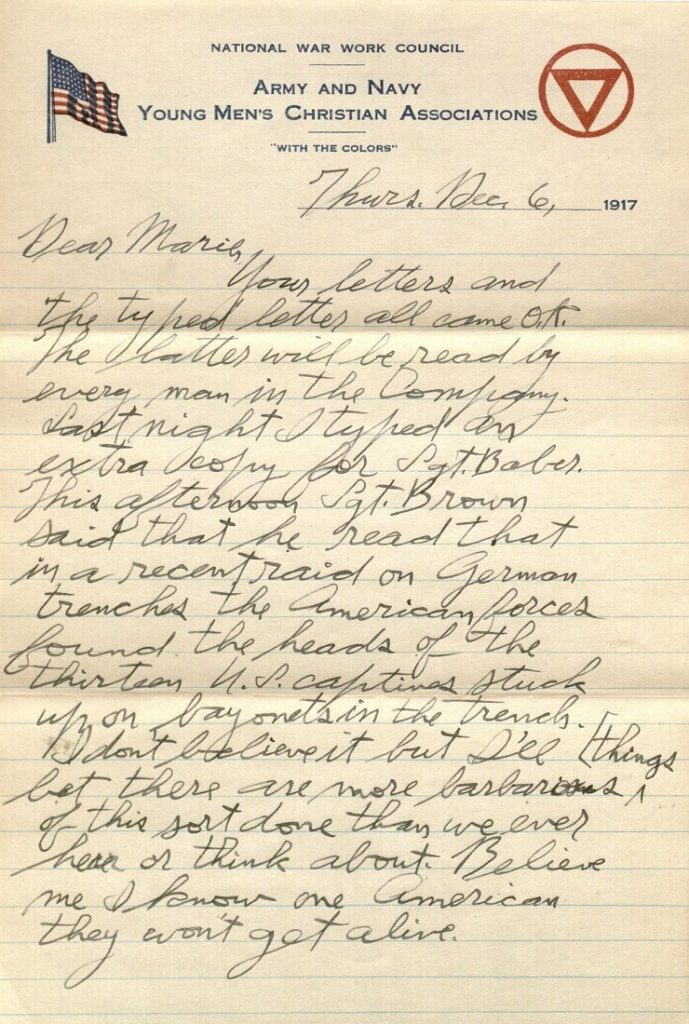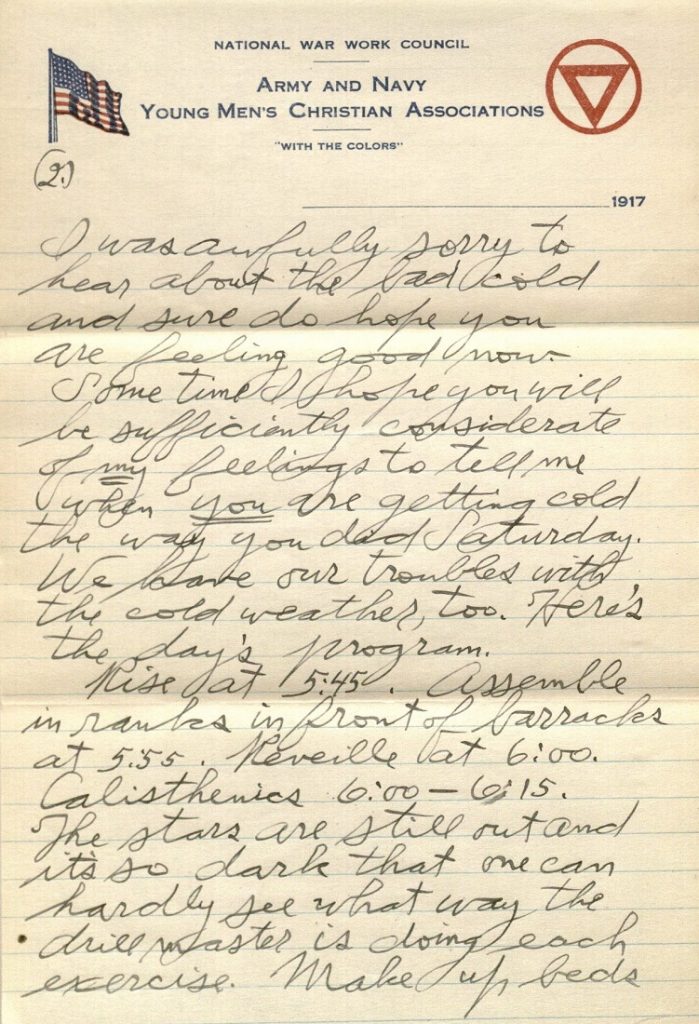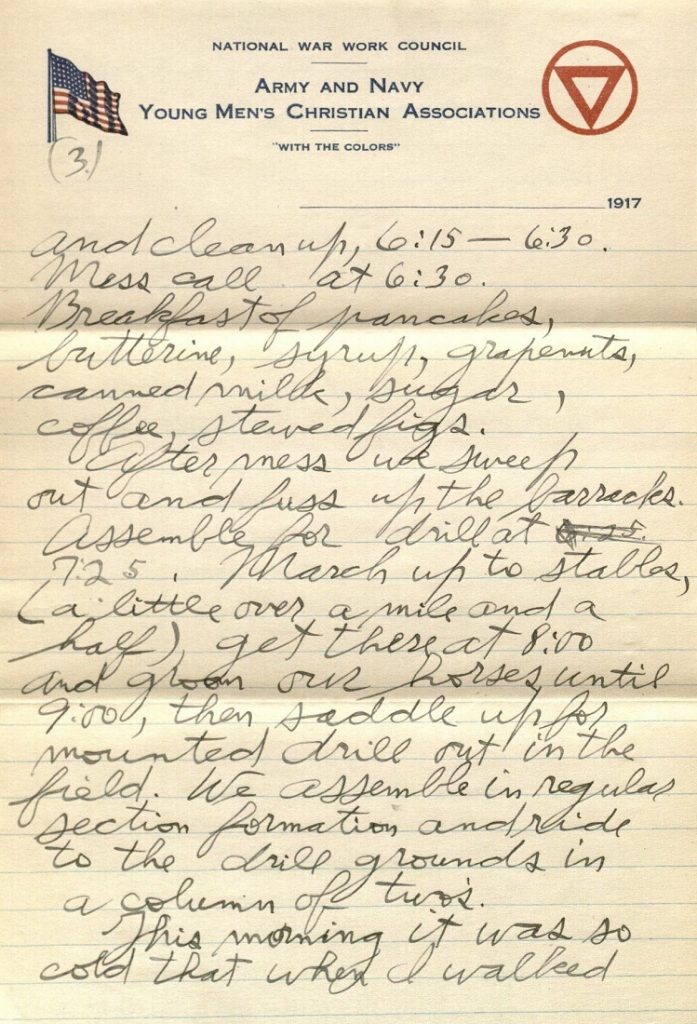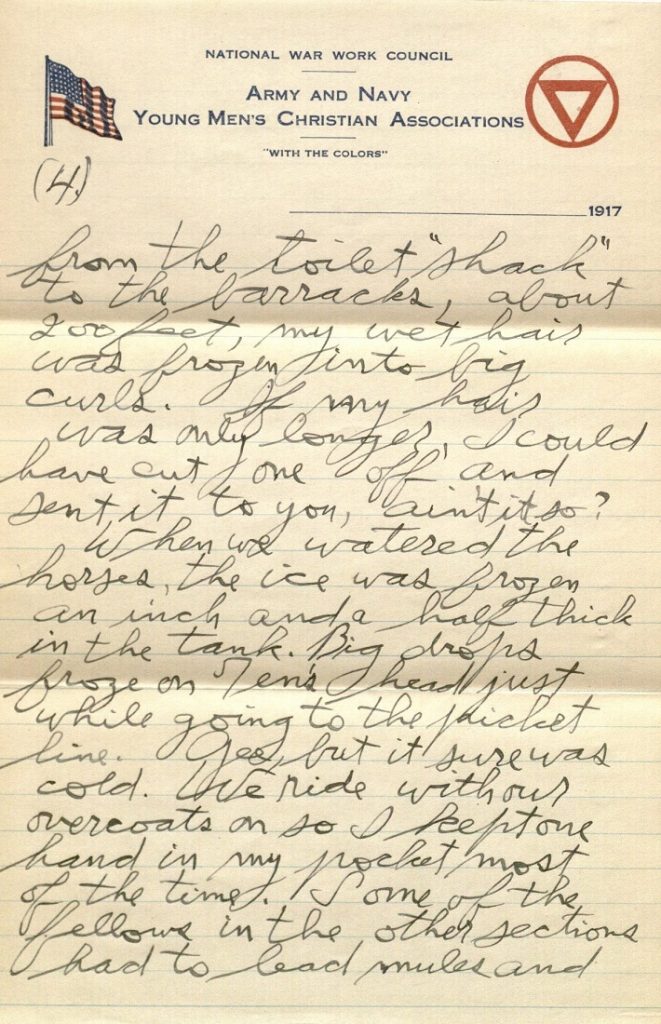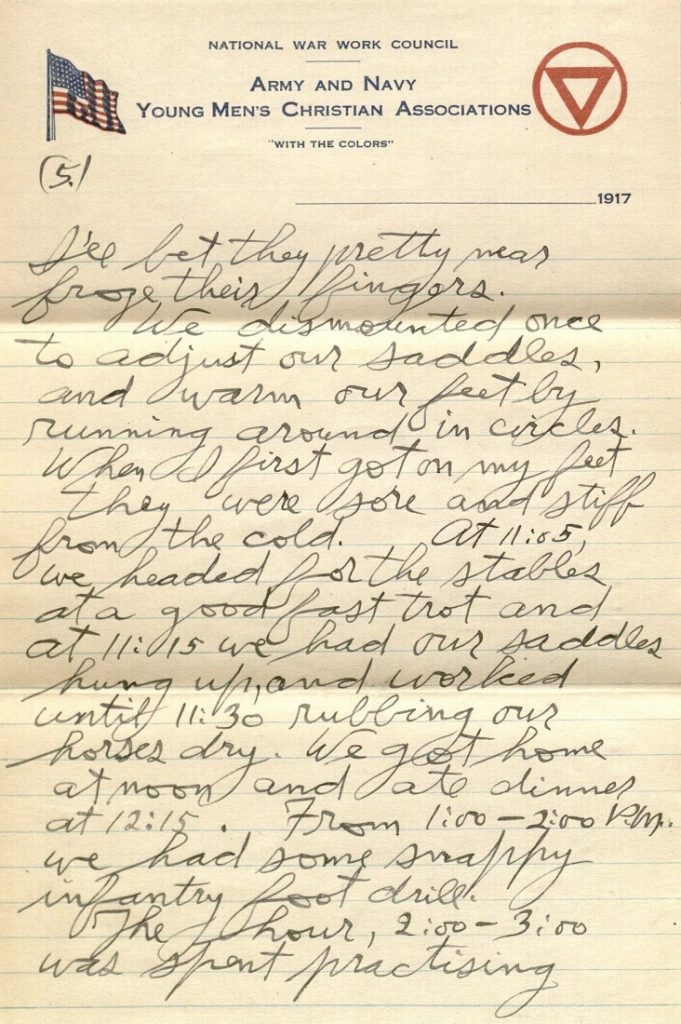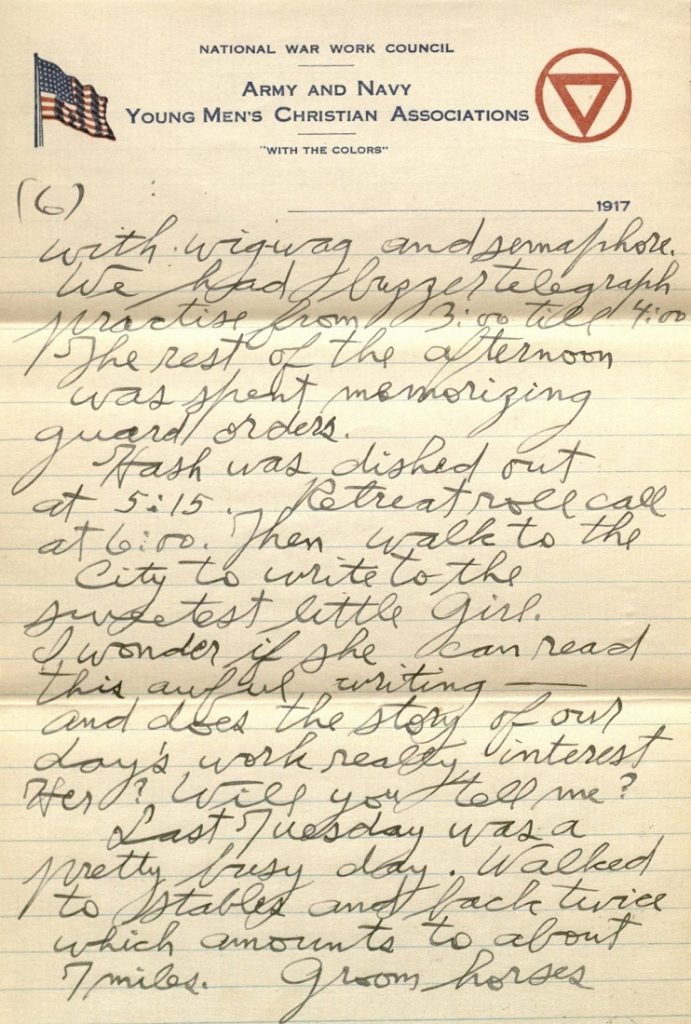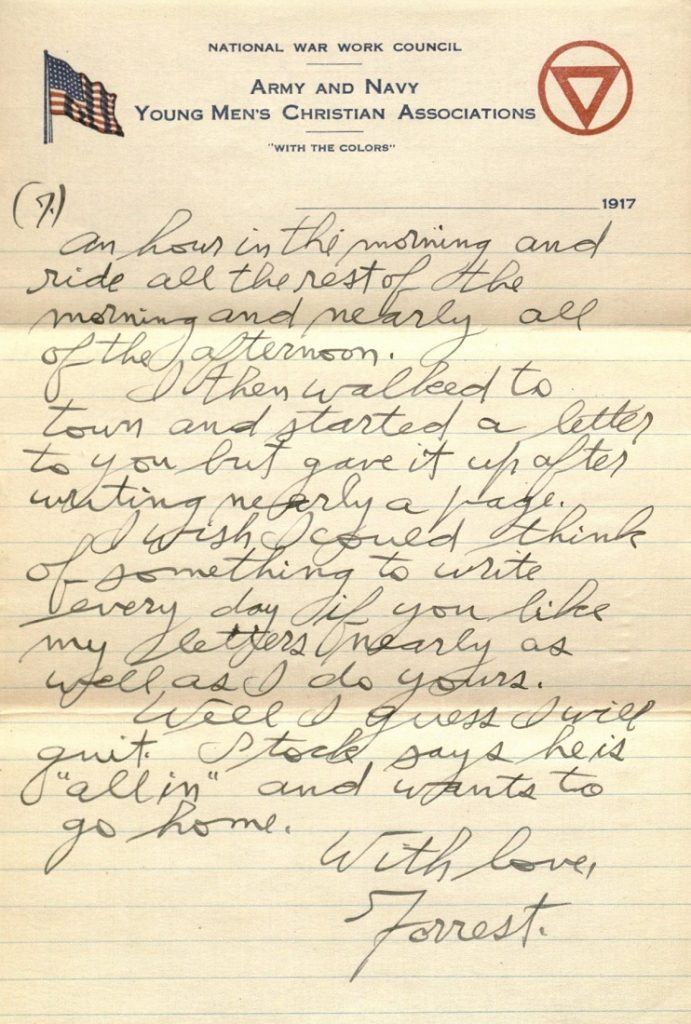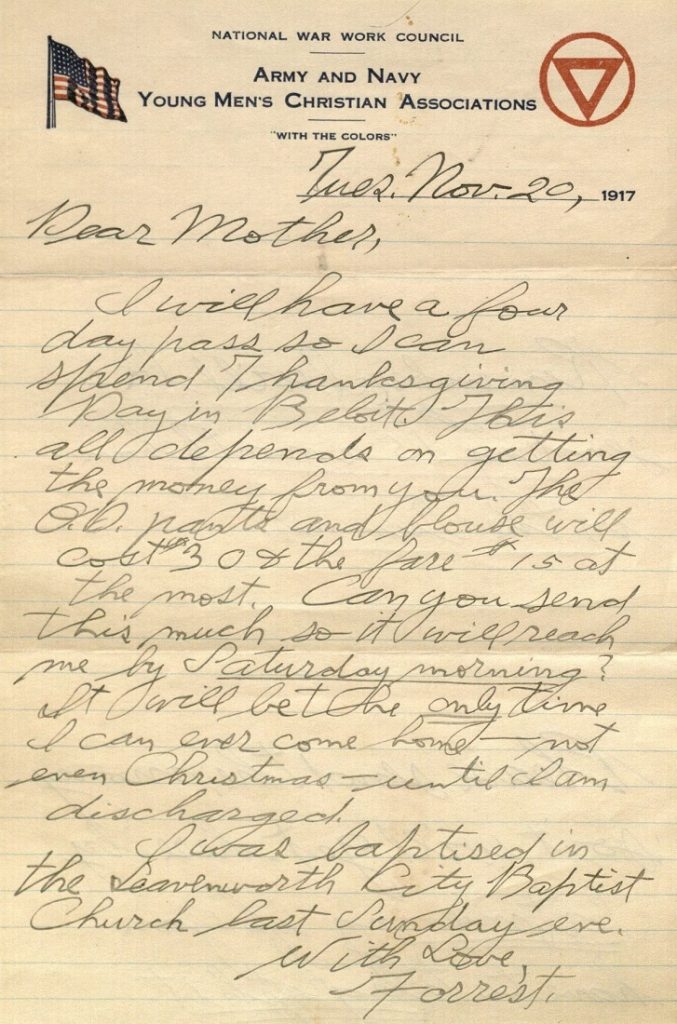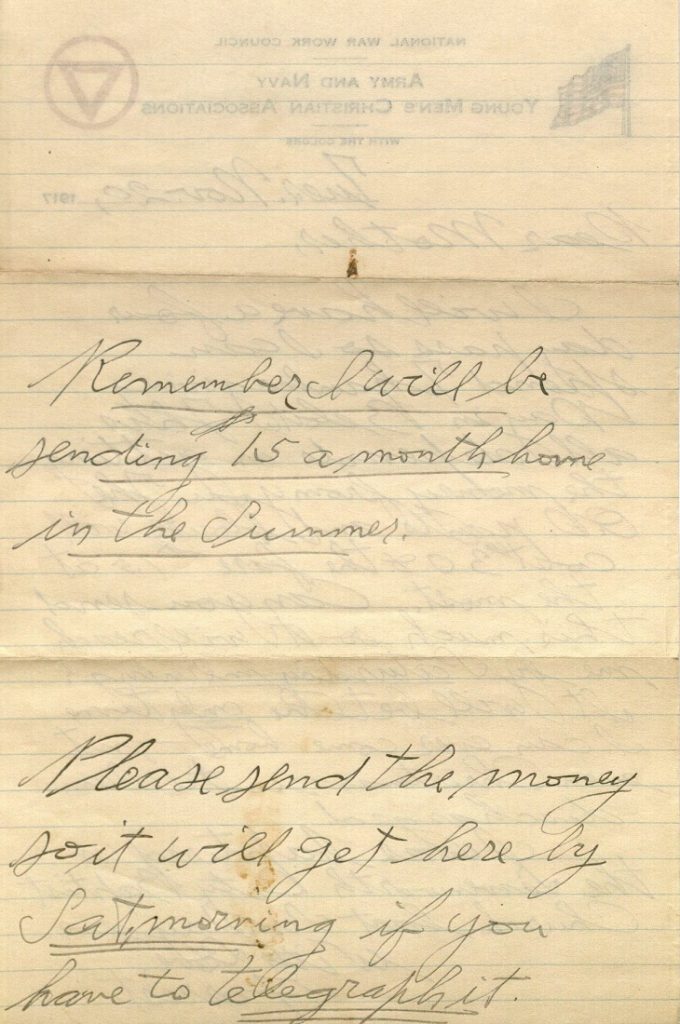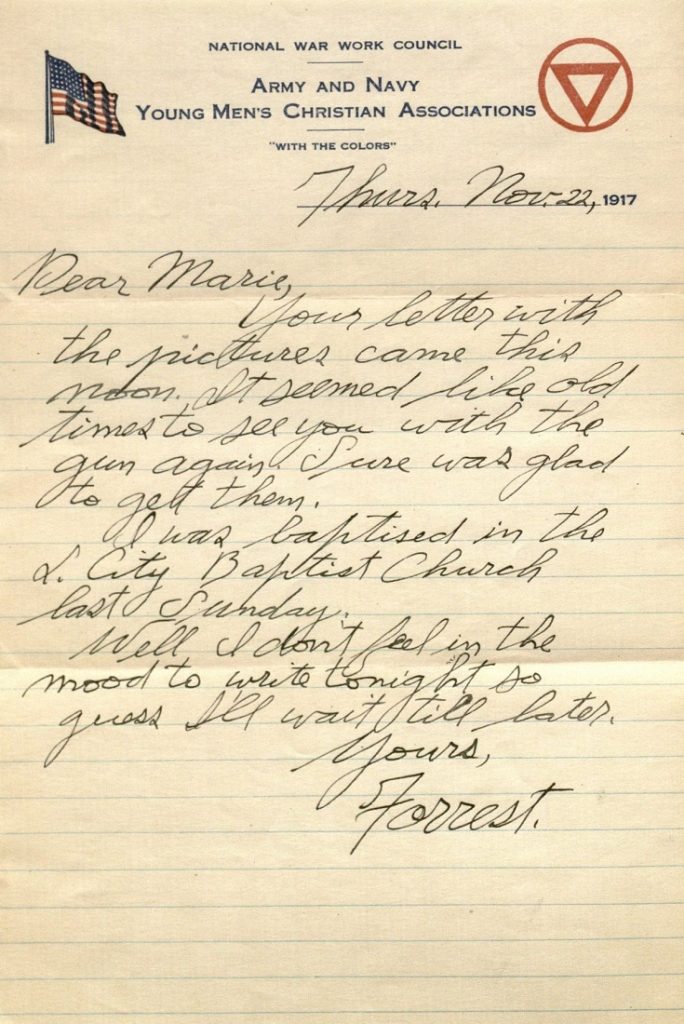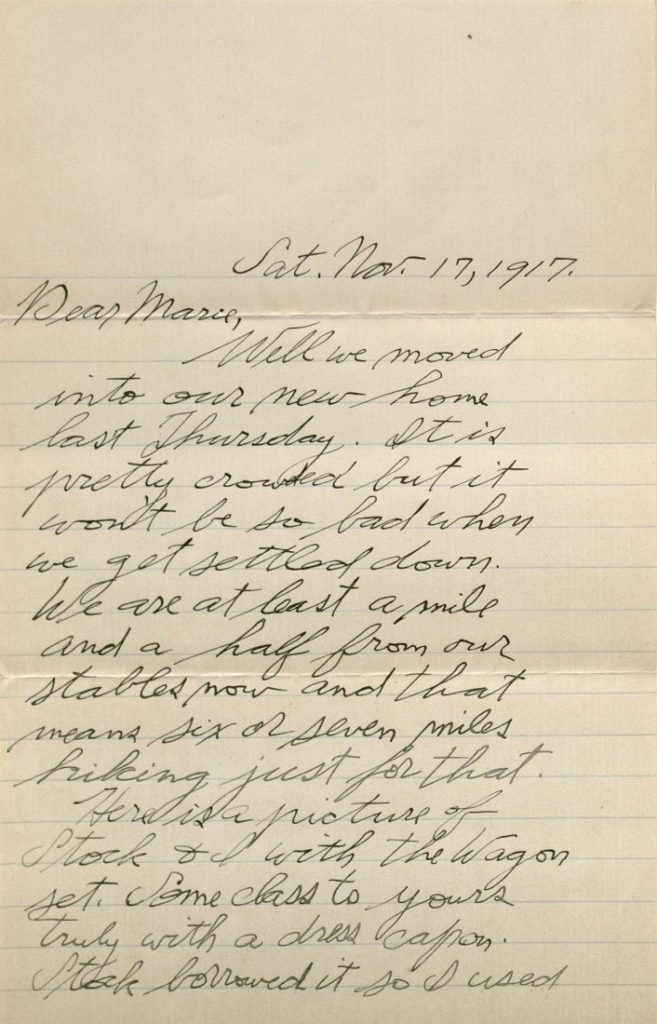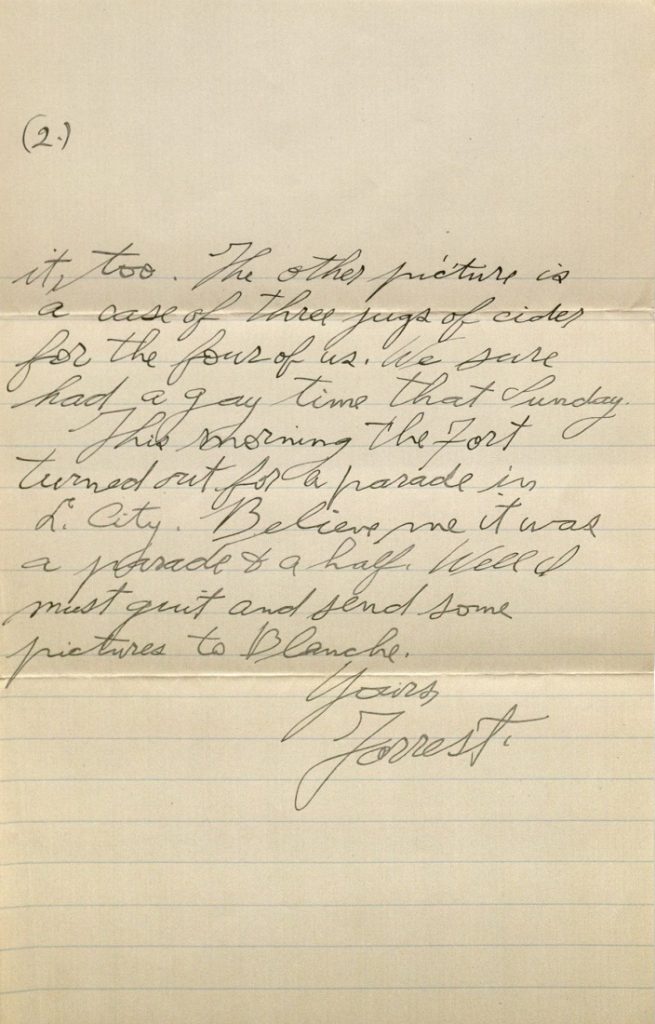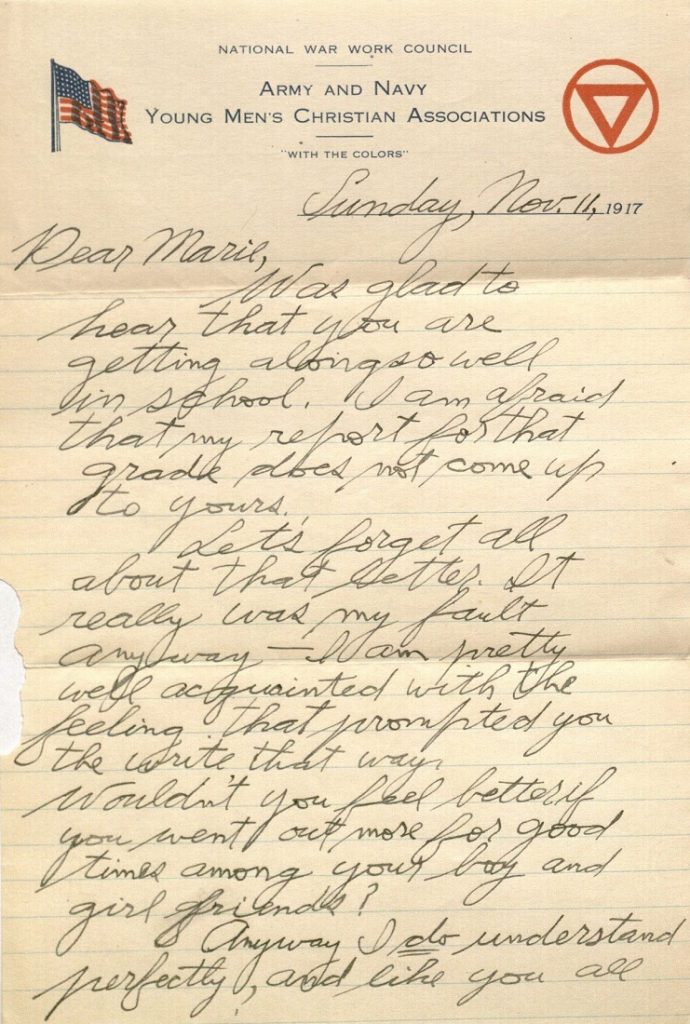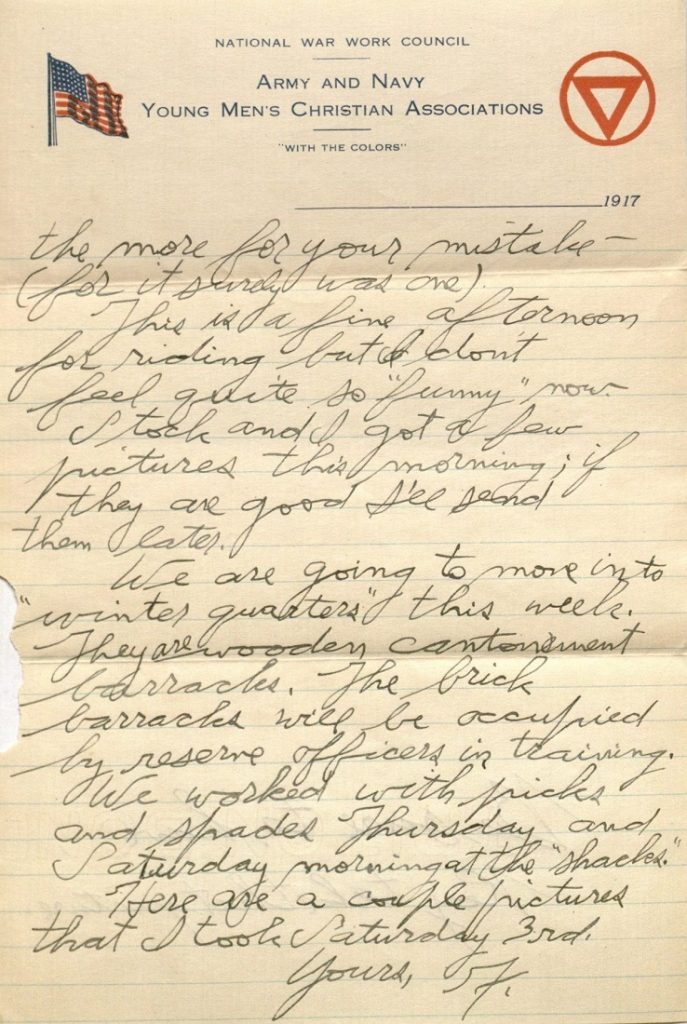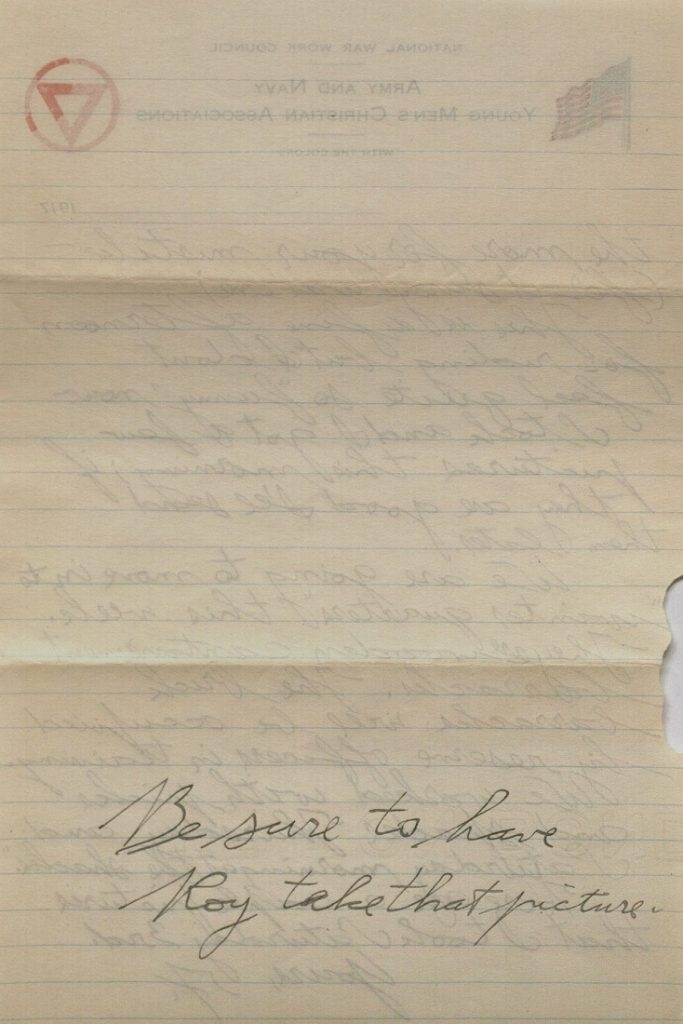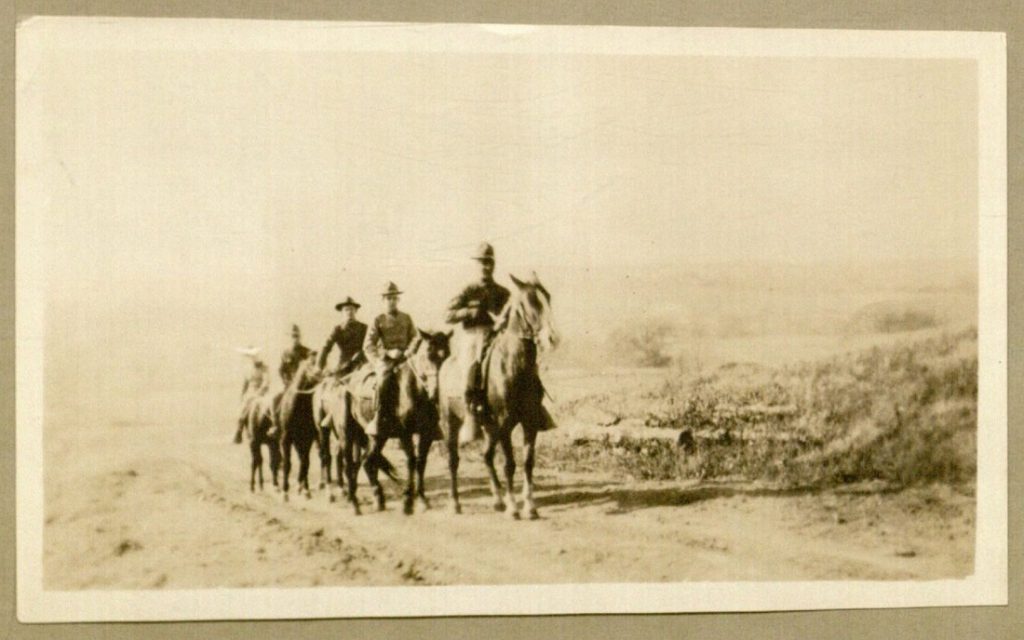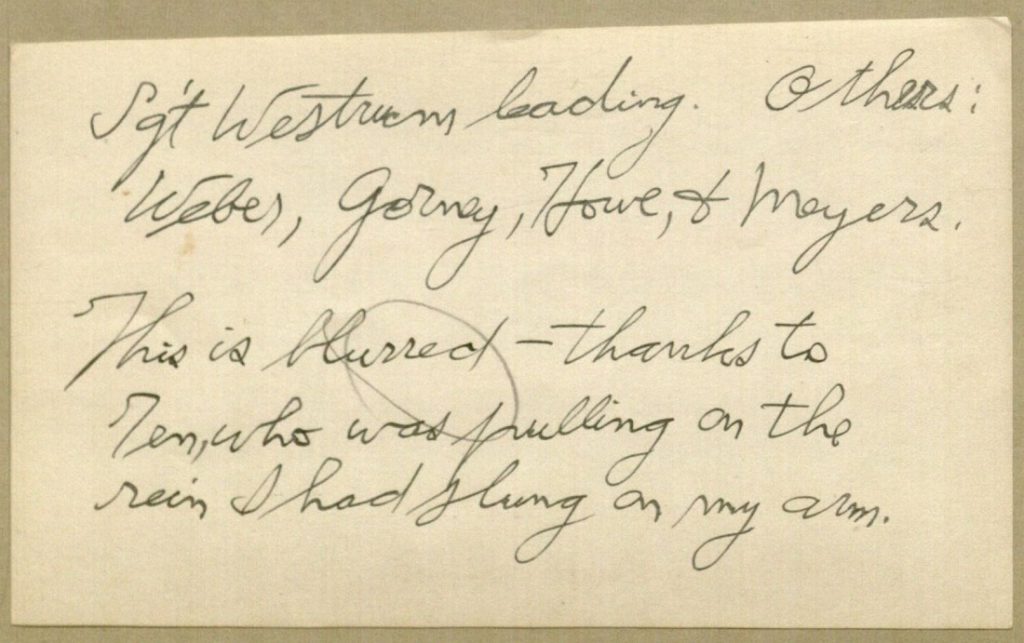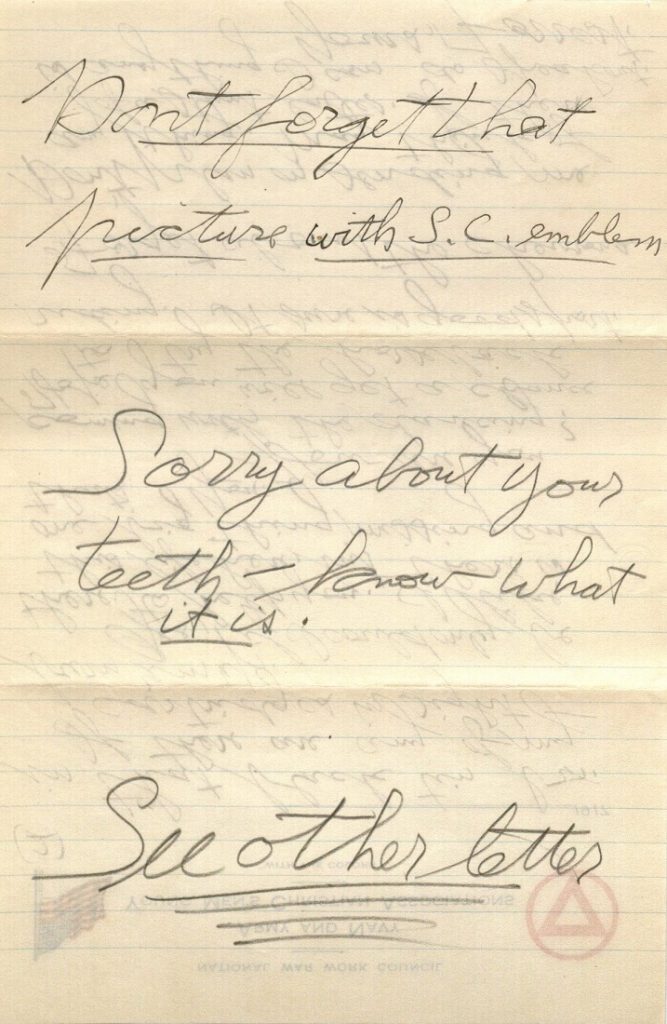World War I Letters of Forrest W. Bassett: December 4-10, 1917
December 4th, 2017In honor of the centennial of World War I, we’re going to follow the experiences of one American soldier: nineteen-year-old Forrest W. Bassett, whose letters are held in Spencer’s Kansas Collection. Each Monday we’ll post a new entry, which will feature selected letters from Forrest to thirteen-year-old Ava Marie Shaw from that following week, one hundred years after he wrote them.
Forrest W. Bassett was born in Beloit, Wisconsin, on December 21, 1897 to Daniel F. and Ida V. Bassett. On July 20, 1917 he was sworn into military service at Jefferson Barracks near St. Louis, Missouri. Soon after, he was transferred to Fort Leavenworth, Kansas, for training as a radio operator in Company A of the U. S. Signal Corps’ 6th Field Battalion.
Ava Marie Shaw was born in Chicago, Illinois, on October 12, 1903 to Robert and Esther Shaw. Both of Marie’s parents – and her three older siblings – were born in Wisconsin. By 1910 the family was living in Woodstock, Illinois, northwest of Chicago. By 1917 they were in Beloit.
Frequently mentioned in the letters are Forrest’s older half-sister Blanche Treadway (born 1883), who had married Arthur Poquette in 1904, and Marie’s older sister Ethel (born 1896).
Highlights from this week’s letters include Forrest encouraging Marie to attend high school if possible (“these four years are worth a great deal even though one has to study some things that seem to be non-essential”), outlining his daily schedule, and describing extremely cold weather at Fort Leavenworth (“It was 7 below outside and I’ll bet it was 20 below in the kitchen. The water would freeze on the dishes while they drained”).
Click images to enlarge.
Thurs. Dec. 6, 1917
Dear Marie,
Your letters and the typed letter all came O.K. The latter will be read by every man in the Company. Last night I typed an extra copy for Sgt. Baber. This afternoon Sgt. Brown said that he read that in a recent raid on German trenches the American forces found the heads of the thirteen U.S. captains stuck up on bayonets in the trench. I don’t believe it but I’ll bet there are more barbarous things of this sort done than we ever hear or think about. Believe me I know one American they won’t get alive.
I was awfully sorry to hear about the bad cold and sure do hope you are feeling good now. Some time I hope you will be sufficiently considerate of my feelings to tell me when you are getting cold the way you did Saturday. We have our troubles with the cold weather, too. Here’s the day’s program.
Rise at 5:45. Assemble in ranks in front of barracks at 5:55. Reveille at 6:00. Calisthenics 6:00-6:15. The stars are still out and it’s so dark that one can hardly see what way the drill master is doing each exercise. Make up beds and clean up, 6:15-6:30. Mess call at 6:30. Breakfast of pancakes, butterine, syrup, grapenuts, canned milk, sugar, coffee, stewed figs.
After mess we sweep out and fuss up the barracks. Assemble for drill at 7:25. March up to stables, (a little over a mile and a half), get there at 8:00 and groom our horses until 9:00, then saddle up for mounted drill out in the field. We assemble in regular section formation and ride to the drill grounds in a column of two’s.
This morning it was so cold that when I walked from the toilet “shack” to the barracks, about 200 feet, my wet hair was frozen into big curls. If my hair was only longer, I could have cut one off and sent it to you, ain’t it so?
When we watered the horses, the ice was frozen an inch and a half thick in the tank. Big drops froze on Ten’s head just while going to the picket line. Gee, but it sure was cold. We ride with our overcoats on so I kept one hand in my pocket most of the time. Some of the fellows in the other sections had to lead mules and I’ll bet they pretty near froze their fingers.
We dismounted once to adjust our saddles, and warm our feet by running around in circles. When I first got on my feet they were sore and stiff from the cold. At 11:05, we headed for the stables at a good fast trot and at 11:15 we had our saddles hung up, and worked until 11:30 rubbing our horses dry. We got home at noon and ate dinner at 12:15. From 1:00-2:00 P.M. we had some snappy infantry foot drill.
The hour, 2:00-3:00 was spent practising with wig-wag and semaphore. We had buzzer telegraph practice from 3:00 till 4:00. The rest of the afternoon was spent memorizing guard orders.
Hash was dished out at 5:15. Retreat roll call at 6:00. Then walk to the City to write to the sweetest little girl. I wonder if she can read this awful writing – and does the story of our day’s work really interest Her? Will you tell me?
Last Tuesday was a pretty busy day. Walked to stables and back twice which amounts to about 7 miles. Groom horses an hour in the morning and ride all the rest of the morning and nearly all of the afternoon.
I then walked to town and started a letter to you but gave it up after writing nearly a page.
I wish I could think of something to write every day if you like my letters nearly as well as I do yours.
Well I guess I will quit. Stock says he is “all in” and wants to go home.
With love,
Forrest.
Sunday, Dec 9, 1917
Dear Marie,
I sure am awfully sorry to hear that your cold is getting worse, and hope that you will be feeling like yourself again by this time. I know you must feel miserable, especially when you are in school. I wish I could learn to be more careful but did not think for a minute that you were getting cold until you spoke.
You are doing well in school and I am mighty glad to hear it. Keep it up and you will not regret it when you go to High School. You cannot appreciate the value of a little hard work at school, now, but believe in me when I say that you will realize later, the advantages of all the school you can get. Whatever you do, don’t give up the idea of going to H.S. You simply must go if you possibly can. These four years are worth a great deal even though one has to study some things that seem to be non-essential. High school gives one only a fundamental idea of a lot of important things; those graduates who don’t think they “know it all” realize how much there is to learn. One feels an “urge”, or incentive, to think and get a better understanding of things in every day life and also of things that we might otherwise overlook. So remember, little girl, no matter what we will or will not be to each other, if you would take the advice of a good friend, go to High School.
I should be glad to have you make something for me for Christmas. While I told all the folks not to send anything, yet I do want something from just You alone. Would you like to make a box of fudge for my birthday – the 21st? This will be the last box, for I simply must cut out that stuff.
Your picture is in my watch now. I have nearly all the pictures that we took this summer and often take them out and think of the happy times we have had together this summer. Here’s hoping that those we took Thanksgiving will be good. Those three days with You were the happiest I have ever known and I will never forget.
We are having it pretty cold now. Saturday morning it was 7 below, and one sure does feel it here. It snowed all day Friday – the 4th, 3rd, 2nd and 1st sections had mounted drill in the storm, and so I was thankful I’m in the fifth. We have seventy brand new saddles of the very best type so the whole company will ride together soon. Some of the Saddles we have now are the little flat ones with steel stirrups – used by English gentlemen for riding in the parks but useless for our work. It sure is no joke to stick to one of the “pancake” saddles and lead an argumentative mule at the same time. Lieut. Butler said that the fellows were letting too many mules get away, and that the next fellow that let go of the rope before falling from the saddle was going to hear from him. My reputation for hanging on to my mule or lead-horse is without a spot so far, but yours truly is going to kiss that mule goodbye before he will do any Charlie Chaplin flop on the cold, hard ground.
Saturday I was on kitchen police duty and we didn’t have any fire in the dining room at breakfast time. It was 7 below outside and I’ll bet it was 20 below in the kitchen. The water would freeze on the dishes while they drained. We couldn’t mop the floor because the water would freeze before the floor was clean and dry. Even the vinegar froze solid. When I got through fussing with the wet dish towel I thawed out my fingers with cold water. We feed 86 men now. Each private gets “K.P.” about three or four times a month, for one day. Well the Y.M.C.A. wants to lock up so goodnight.
Yours,
Forrest.
Meredith Huff
Public Services
Emma Piazza
Public Services Student Assistant

